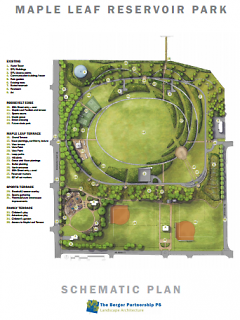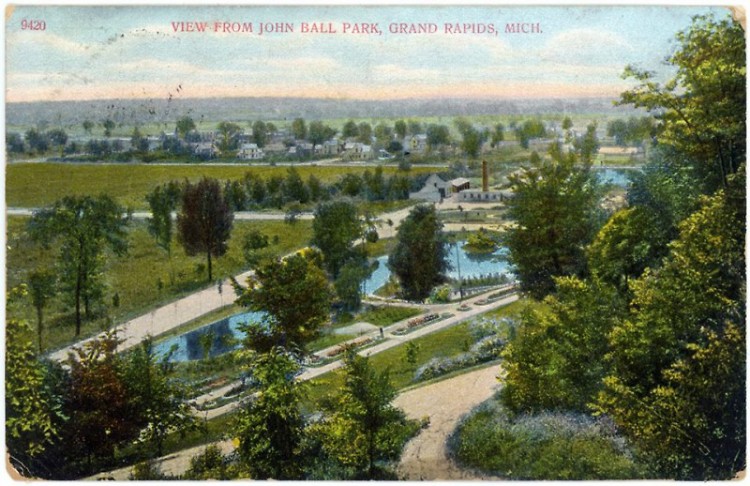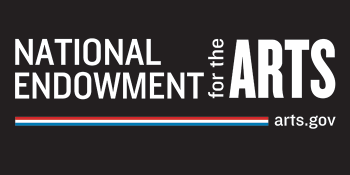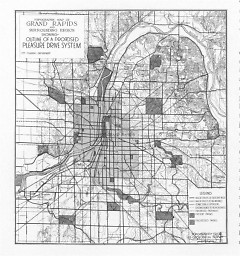During the last few months there has been a lot of discussion about the history, value and funding of parks in Grand Rapids. Last month, The Rapidian featured a three part series “Why Parks Matter” by Michael Tuffelmire where he explored the past of the Grand Rapids parks, the need for parks in a city, and the current conditions of our park system.
In Grand Rapids, our early park acquisition and development was informed by major urban planning, landscape design and social movements at the turn of the 20th Century.
- The City Beautiful Movement sought to improve cities through beautification, which would result in social ills being swept away, as the public was inspired to be loyal to civic ideals and stay committed to urban areas. The 1908-14 design of John Ball Park was likely our closest example of this movement informing local parks design.
- The Prairie School of Landscape Design held strong to a nature-based approach to designs for public and private space and their ability not only to provide a refuge from the city and daily life, but also to serve as preserves for native plant species. In Grand Rapids, Garfield Park still reflects this design approach as park and preserve.
- The American Playground Movement was a wide coalition of child-saving reformers including social settlement house workers, progressive educators and child psychologists that believed supervised play could improve the mental, moral, and physical well, being of children. Locally, Charles Garfield, made Grand Rapids a leader in the national playground movement, fighting for access to play and playgrounds to open on Sundays. Charles Garfield donated a small playground, Cheseboro Park, just east of Garfield Park because of his "love for Grand Rapids...and faith in its future."
These movements weren't without controversy, but they captured the hearts and minds of our community. That was followed by people donating park land and investing in creating great urban parks like John Ball, Riverside and Garfield. Leaders in the community exerted their influence to create parks, at times in the face of great opposition. Current park development has a whole new set of challenges and opportunities as people once again are looking to parks to make cities more livable, exciting and sustainable.
The next era of parks needs to look back at what made the parks movement in our country and city so successful, but also learn from our mistakes.
- The best parks in Grand Rapids are those that are central to neighborhoods and the City. The parks that continue to struggle are those built on the edge of neighborhoods as buffers, or on land that could not find other uses. Moving forward, we must not settle to just build parks in places where nothing else can be built or where the land is cheap. The next era of parks will require the redevelopment of existing sites, mostly industrial, and the integration of the existing built environment, and creation of natural areas. Parks can't just be an afterthought, but central to quality urban redevelopment.
- Parks will gain in importance as the places that pull us back together as a community. Recently Tim Gleisner wrote this piece in The Rapidian “Parks as Place Makers Record Our City’s History.” “For our city, like any other community, there have been events at different times that have helped create the community in which we live. Our parks recall the scenes of our community's memories,” says Gleisner. We must acknowledge and preserve our past while adapting to new uses and user groups. Parks can change as the city changes by creating great spaces that can evolve and serve multiple purposes over time.
- We need our parks to do more for us now than ever before. Beyond just the inherent value of being a place to relax and play, we must embrace sustainable park design principles and guidelines i.e. power generation, stormwater management, native plants and recycled materials. We must also look to a more diverse funding portfolio and new public and private partnerships to not just develop parks but also ensure ongoing operations. Park must "work" for us, as well as be places of play.
Let's continue the dialogue about what value park have in Grand Rapids past, present, and future.
The Rapidian, a program of the 501(c)3 nonprofit Community Media Center, relies on the community’s support to help cover the cost of training reporters and publishing content.
We need your help.
If each of our readers and content creators who values this community platform help support its creation and maintenance, The Rapidian can continue to educate and facilitate a conversation around issues for years to come.
Please support The Rapidian and make a contribution today.



